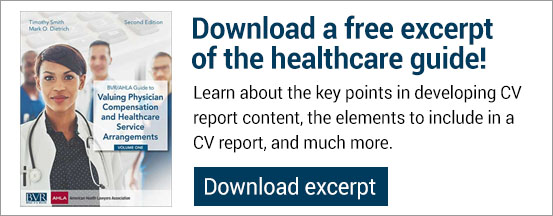Key Points for Developing Compensation Valuation Report Content for a Healthcare Appraisal
No specific professional standards govern the content and requirements for appraisal reports in compensation valuation (CV), and there is very little professional literature on this topic. In the absence of any professional guidance, CV practitioners have generally fallen back on business valuation reporting standards for direction in preparing valuation reports. In the BVR/AHLA Guide to Valuing Physician Compensation and Healthcare Service Arrangements, author Timothy Smith, CPA/ABV (TS Healthcare Consulting), looks to the business valuation standards and discusses how to adapt and expand on these standards to address areas that are unique to CV practice and appraisal issues.
Developing templates for CV reports and exhibits that go along with them can be a daunting task for appraisers. Appraisal reports need to be set up for efficient and timely completion, and the greatest challenge of report writing is figuring out how to balance all of the important factors that go into them. Below is a list of key points to take into consideration when tackling your next healthcare compensation valuation report.
Guidance From USPAP and BV Reporting Standards
One can observe a fair amount of consistency in the information requirements for valuation reports from the various business valuation standards. While some of the categories or terminology may vary, the basic content elements are very similar or comparable. As noted above, the various report elements that are recommended for CV reports were developed from these business valuation standards. Not every requirement from the business valuation standards crosswalk to CV, however, because of certain differences in the two types of valuation work. Yet, those that do not crosswalk can usually be adapted for use in CV.
Sufficient Information on the Scope of Work
As a starting point, it may be helpful to look at the reporting requirement of the Scope of Work Rule from the Uniform Standards of Professional Appraisal Practice (USPAP). While USPAP does not apply to CV and does not govern all appraisal professionals, it is a major touchstone in the profession. The Scope of Work Rule states that an appraisal “report must contain sufficient information to allow intended users to understand the scope of work performed.” This simple and straightforward requirement is perhaps the best standard for thinking about the issue of report content for CV. A report needs to tell the user what the appraiser did to reach a conclusion of value.
The Scope of Work and the Work File as the Foundation for the Report
While reports are critical to the valuation process, what may matter most in an assignment is that the appraiser completed an adequate scope of work to arrive at a supportable conclusion of value. A great report doesn’t make up for poorly conceived and implemented appraisal work. The most important and detailed record of that work is what is maintained in the appraiser’s work papers and work file for the engagement. The report will usually be a summary at one level or another of the work completed, unless you want to write a really long report. Firms that have had their reports subjected to litigation will tell you that you need to have your work files and work papers in order and in sufficient detail to support the conclusion of value. It is helpful, therefore, to think about valuation reports as a summarized version of the work file. Step 1, however, is to ensure the work file is in order.
The Level of Information in a Report
Another useful distinction found in the BV standards is the idea of a detailed or summary report. Both types of reports have the same basic content requirements, but the summary report provides a more concise version of what is included in the detailed reports. This distinction makes an important point: A report is more or less the story of what we did to arrive at a conclusion of value. We can tell the short or long version of that story, as long as we make sure to include certain key parts in the plot.
The two types of BV reports under USPAP—an appraisal report and a restricted appraisal report—appear to make a similar distinction with regard to the content and level of information in a report. The intended use and users of the report are what determine the appropriate level of information. When the intended user of a report includes only the client, a restricted appraisal report may be used. This type of report must include the warning that “the appraiser’s opinions and conclusions set forth in the report may not be understood properly without additional information in the appraiser’s work file.” In other words, less information is included in the restricted report than in the nonrestricted version. The scope of work and the contents of the work file, however, do not change.
Conclusion
In short, developing report templates for compensation valuation is no easy task. To read more about the content elements to include in a CV report such as assignment elements, client and intended users of the report, purpose and the use of the valuation, and much more, download a free excerpt of the BVR/AHLA Guide to Valuing Physician Compensation and Healthcare Service Arrangements.
For more on the topic of healthcare appraisals, be sure to join expert Timothy Smith for a live webinar on Jan. 9, 2019, when he and Nicholas Newsad of Healthcare Transaction Advisors will cover how to use government data sources to revolutionize healthcare valuation.

